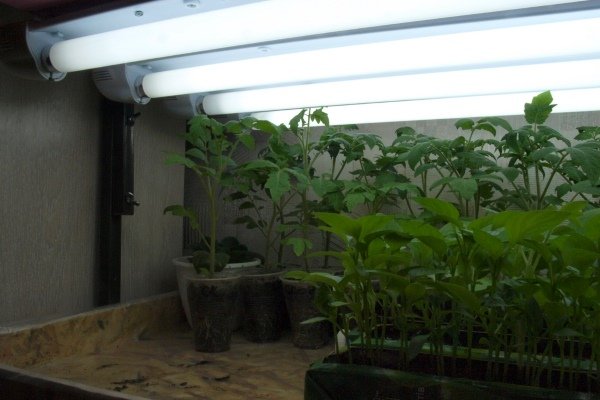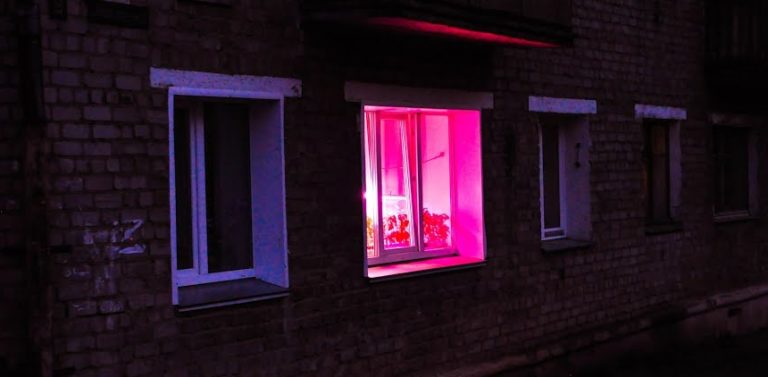Features of fluorescent bulbs for plants
For the full growth of seedlings and flowers requires a sufficient amount of light. If there is a lack of natural light, you can use a fluorescent lamp for plants. Its characteristics affect growth and yield, so the choice of model matters.
In addition to fluorescent use LED, discharge and incandescent lamps. Let's talk about the features of each of the devices.
Why do plants need a lamp
Daylight is required by greenery for photosynthesis and development. The range of radiation serves to produce chlorophyll, which is the muscle mass of green. If there is not enough light, the sprouts will begin to stretch upward to capture as much of the sun's rays as possible. In doing so, the plants spend all their energy growing, depleting their stems and not being able to grow enough dense foliage.

This blocks flowering as the flower lacks energy. To compensate for the lack of daylight, special fluorescent lights are installed for ornamental plants. The same cultivation technology should be used when planting seedlings in chernozem. This is done in early spring, when the daylight hours do not exceed 4 hours. For indoor plants, it is recommended to use additional lighting all the time.
What lamp for plants to choose
The type of daylight lamp is chosen taking into account the characteristics of the culture:
- Light-loving. Refers to the culture of northern growth. For normal development, you need to turn on the backlight for at least 15 hours a day. This means that the lamp must have a long life, at least 20,000 hours;
- shade-loving. Require backlighting 6-8 hours a day. A model with a resource of 6000-7500 hours will do;
- Medium light, up to 8 -10 hours a day. Need lamps with a lifetime of up to 10,000 hours.
Speaking about the characteristics of the bulbs, pay attention to:
- the parameters of the socket. Use pin sockets and threaded E14 and E27.
- power. Depends on the size of the bulb. For example, if the length of the lamp is 0.5 m, the power will be 18 watts, and at 1.5 m - 58 watts. The power rating is not affected by the intensity of the radiation;
- moisture protection. If the daylight lamp will be installed in a greenhouse or aquarium, it must have a polymer protection against moisture;
- voltage. Usually it is the standard 220 volts.
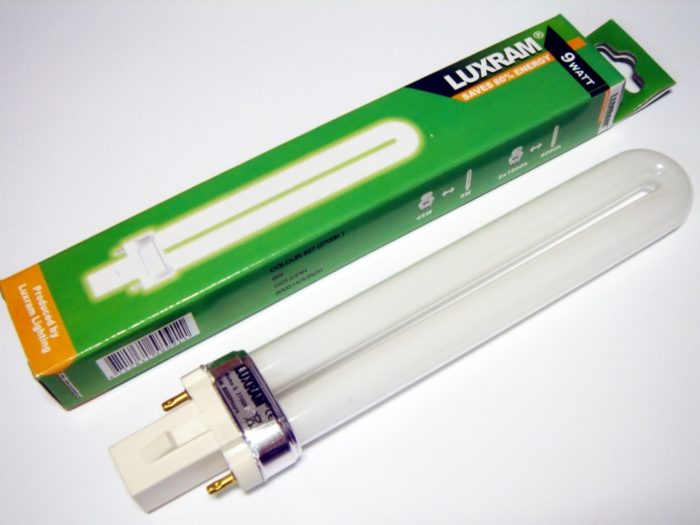
Bulbs come in a variety of sizes. Compact ones can be installed in standard light fixtures. The plant may require daylight, cool or red light.
Linear ones are tubular products with a length of up to 1.5 m. They are fixed above the seedlings in greenhouses on ropes, racks and shelves. Modern devices are economical and give intense light.
Overview of popular models
Popular daylight lamps for plants:
| Model | Size (mm) | Luminous Flux (Lm) | Application | Prices |
| Fluora L15W | 450 | 400 | Used at home and for seedlings and installed in an aquarium as additional lighting with a shortened light day. | 570 |
| Osram L58W | 1490 | 2255 | Fitted in large greenhouses and nurseries. One of the best options for ag crops during the fruiting and flowering period. Use as a single light source. | 950 |
| Fluora L30W. | 895 | 1000 | Mounted in greenhouses, on racks and window sills for plants that need to gain green mass, as well as in the flowering period as additional lighting. | 675 |
| Osram L36W | 1200 | 1400 | For medium-sized greenhouses, nurseries and flowering plants as a single light source. | 720 |
| Fluora L18W. | 590 | 550 | At home for plants in the growing season and newly planted seedlings. Can be installed as a supplementary light if the daylight hours are short. | 610 |

How to calculate the amount of light
Experienced gardeners recommend calculating the intensity of radiation, starting from an area of 10 x 10 cm. To illuminate an area of 1 dm2 is required:
- Light-loving in the absence of natural light more than 2.5 watts;
- medium intensity - from 1.5 to 2 watts;
- For heat-loving crops with insufficient natural light - 0.5-1.5 watts.
Lighting installation tips
Before installing a lamp, you need to learn how to correctly identify the spectrum. For example, red and orange colors stimulate photosynthesis and plant energy production, but are negative for flowering. A range from lilac to green is appropriate here. Yellow stays neutral.
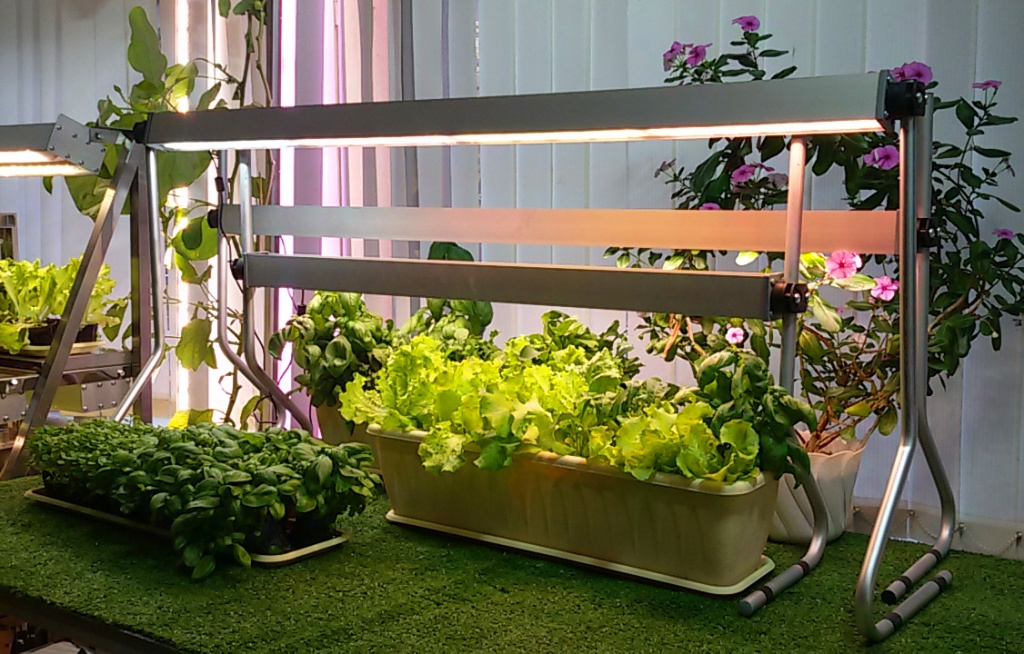
If shade-loving plants are grown, the lamp should be mounted at a distance of no more than 50 cm, light-loving - no more than 15 cm. It is recommended to install the pots at the same height with each other. Flowers that like light more than others, it is better to put in the center, the rest on the edges. Fasteners for the lamp should move around the perimeter of the room.
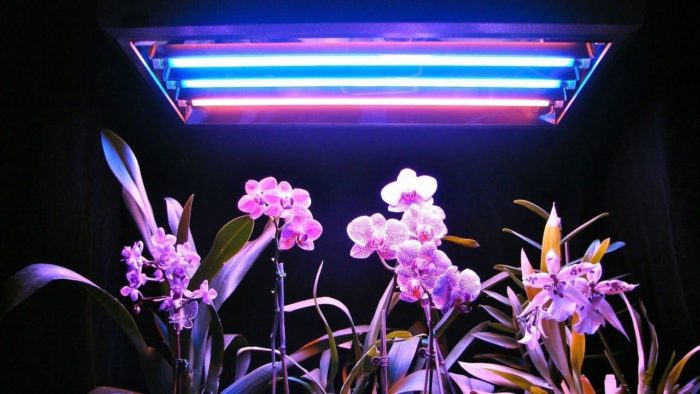
It is best to turn the lights on in the evening or at night, and turn them off during the day, when there is enough natural light. A reflector should be placed on the top and side of the lamp to reflect light to distant areas. Porcelain enamel, mirror or foil film are used as reflectors. The surface should be wiped with a clean cloth.
Rules for using the lamp
Yellow color inhibits the growth of the stem, so the peak spectrum is suitable for stem and aquarium plants, such as dracena and ficus. To enhance the effect, you can install the light closer to the flowers, but not too much. In winter, the light time can be increased by 2-3 hours.
Turn on fluorescent lamp too often is not worth it, it has a negative effect on the service life. It is possible to install the devices, if there are no voltage fluctuations in the network.
Topical video: Comparison of fluorescent and LED lamps for seedling lighting
Since there is mercury vapor inside the fluorescent light, it is recommended that you install it in a safe place away from children. If the light is transported to another location, take care to place it in a stable position to avoid mechanical damage. Only use gloves when replacing the light bulb. If greasy residue is left on it, it can cause an explosion when heated.
Advantages and disadvantages of using
The main advantage of fluorescent bulbs is that they do not shine hot, so flowers do not get burned. There are other advantages as well:
- The duration of operation;
- high color rendering performance;
- economy;
- optimal spectrum for plant growth;
- affordable prices.
Disadvantages:
- Difficulty in connection;
- when failing require special disposal;
- high cost of quality models;
- inside the lamp there are harmful substances;
- The quality of light transmission decreases over time.

Conclusion
Another advantage of a fluorescent lamp - it can be used by experienced growers and beginners, it is enough to study the features of installation and rules of operation. At low prices, the devices cope with the load and serve for a long time.
